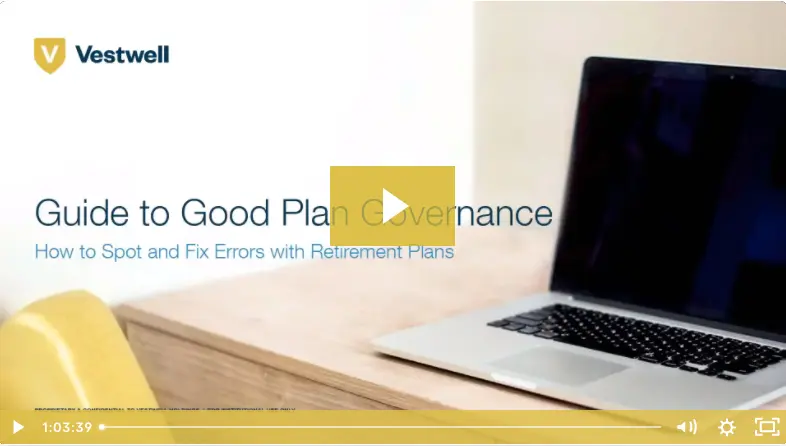
Guide to Good Plan Governance: How to Spot and Fix Problems in Your Clients’ Retirement Plans
With increased oversight of retirement plans, continually changing regulations, and developing legal standards, it is easy to see why plan sponsors can become confused and even overwhelmed by their fiduciary obligations. Plan sponsors may not know where to start. This guide can be used by the advisor or given to the plan sponsor as a helpful framework on how to operate a plan, from understanding what documents should be created and maintained, to how to establish and run plan committee meetings. Vestwell is not a law firm and cannot give legal advice. Plan sponsors may wish to consult with counsel to understand the requirements applicable to them.
1. Introduction
Why Do Plan Sponsors Need Plan Governance?
Contrary to popular belief, a plan sponsor cannot completely delegate away its fiduciary responsibilities. While sponsors can, and many should, engage qualified service providers to handle various administrative and other activities, sponsors will always retain some level of fiduciary duty. In order to carry out those obligations, sponsors should implement regular processes and procedures to help minimize risk, create efficiencies, and drive the best outcome for the employer and participants. Plan governance is the administrative oversight that helps the plan sponsor maintain a compliant retirement plan.
2. Getting
Writing the Plan Documents
For plan sponsors that have never had a retirement plan, the array of options and features can be intimidating. A good consultant can analyze your workforce demographics to design a plan that your employees will actually use and that will achieve your goals. However, the plan sponsor should first consider a few basic questions.
- Which employees should be allowed to participate in the plan and which should be excluded? A plan may provide that all employees are eligible to participate or it can impose restrictions, such as an age or service requirement. The plan sponsor may decide to exclude certain specific categories of employees, such as collectively bargained employees and part-time or temporary employees. While there are some legal limitations, the sponsor is generally free to decide which employees can participate in the plan and when they should be allowed to enroll.
- Do you want to make a contribution to the plan and, if you do, are you prepared to have a mandatory contribution or do you want flexibility as to the amount of any contribution? Many 401(k) plans offer an employer contribution feature such as a profit sharing contribution or an employer safe harbor contribution. Different contribution types have different requirements. Your Vestwell Client Success Partner can explain them.
- Will your plan permit rollovers, in-service withdrawals, and loans? Many plan sponsors allow new employees to roll over their account balance from the 401(k) plan of a previous employer or to access their current account balance for hardship withdrawals, loans to buy a primary residence, and other in-service distributions.
- What form of benefit distribution would you like to make available when a participant terminates employment or retires? The most common form of distribution offered by 401(k) plans is a single lump sum, but some plans offer installment payments over a number of years or annuities based on the participant’s life expectancy.
- Do you think your plan will pass annual compliance tests? All tax-qualified retirement plans must be made available to a fair cross section of highly and non-highly compensated employees. Depending on the nature plan as a Safe Harbor plan, which does not need to undergo most of the annual compliance tests, but as trade-offs, the plan sponsor needs to offer a match to all participants and will not be able to make most changes to the plan during the plan year. Your Vestwell Client Success Partner can help you determine if a Safe Harbor plan is a good fit for you.
Sponsors should also consider adding several policies, depending on the features you want to include in the plan, such as loan eligibility rules, hardship withdrawal rules, and an Investment Policy Statement (IPS). While not legally required, an IPS sets out the standards for selecting and monitoring investment options to help guide the plan fiduciaries in choosing the investment options for plan participants. If the plan will permit loan, it should also have a loan policy so that participants understand how to apply for a loan, the application submission process, and any limitations on obtaining a loan.
Vestwell will work with you to create plan documents that include all of the required legal provisions.
3. Managing Your Plan
Create a Plan Governance File
Now that you have a retirement plan for your employees, your next step as a plan fiduciary is to create a file system to store all plan-related documents so that they can be easily available to all plan fiduciaries and regulators.
A filing system should include sub-folders for each of the following:
- Documentation to establish the plan and, resources permitting, an internal retirement plan committee (see p. 4 for more information on setting up a committe and p. 6 for related documents). This includes:
- Initial meeting minutes to establish a retirement plan
- Selection of committee members
- Signed acknowledgments that all committee members have accepted their role and the fiduciary duty to the plan
- Signed plan documents with sub-folders for:
- Any legally required or voluntary amendments
- Adoption agreements
- Board resolutions
- Summary Plan Description and Summary of Material Modifications
- IRS determination letters
- All communications given to participants about the plan
- Documentation of meeting minutes and all proof of ongoing plan committee activities. The best way to demonstrate that you have fulfilled your fiduciary responsibilities is to document all activities relating to the plan. We provide a sample template for creating meeting minutes, but even an email recapping any discussions about the Plan would be sufficient.
- List of all outside service providers, a summary of their services, and copies of their contracts. It is important for all plan fiduciaries to understand which organizations are responsible for the various plan-related support services.
- A list of every individual or entity (internally or externally) with some level of oversight responsibility for the plan, with clear explanation of each area of responsibility.
- Fee disclosures and all other notices that have been sent to participants. Did you know that even informal communications to participants can create a binding obligation on you to provide various benefits? Make sure all communications to participants are clear and consistent with each other and the plan documents. Keep copies of these documents permanently so that you can come back to them if any issues arise.
- Copies of any fiduciary liability insurance and required fidelity bond from your insurance provider. ERISA requires that plan sponsors and anyone else who handles Plan assets must have a fidelity bond. You can apply for one here or obtain one through your own insurance broker.
- Documentation of your attendance at educational webinars and meetings about fiduciary best practices (examples include Vestwell U webinars as well as free webinars offered by the Department of Labor). It’s worth repeating: the best way to demonstrate that you understand and carried out your fiduciary responsibilities is to document your activities.
- Documents relating to the plan’s investment options, which include:
- An IPS - if you are using the Vestwell full turnkey solution, your plan will follow our IPS
- Copies of all prospectuses for each investment option in the plan - we post fact sheets and prospectuses for the investment lineup on our platform
- Investment comparison charts showing how the investments available to participants compare with the relevant benchmarks - Vestwell provides these to plans that use our full turnkey solution.
- Reports of investment returns, market trends, and risks
- Annual investment review
- Records of transactional compliance for loans. Make sure that loan applications are reviewed and approved consistently with the plan documents, keep records of all loans in arrears or in default, and all loan repayments. The same rules apply to hardship withdrawals.
Ongoing: Carry Out and Document Your Ongoing Plan Activities
Plan sponsors' responsibilities only begin when the plan is established. They must continue to oversee the Plan's operations and make sure that the plan is administered consistently with the plan documents. That may be easier said than done. Here are some helpful rules of the road.
- Prudently select and monitor vendors - Whether your vendors are fiduciaries or not, you are responsible for appointing and monitoring them. If they are not fiduciaries, like most recordkeepers, you are responsible for their mistakes and therefore you have an obligation to oversee their activities. When selecting plan vendors, it’s important to understand any conflicts that service providers may have and how they manage it.
- Make sure your plan is operated consistently with the plan documents and your intentions - It may be surprising how easy it is to administer the plan in a way that violates legal and regulatory requirements. One common operational failure occurs when the terms of a plan do not actually exclude employee classes (such as part-time or temporary employees), but the employer excludes them anyway. Or, the plan may permit the exclusion of part-timers and temporary employees so long as such employees do not work 1,000 or more hours of service in a plan year, but the company fails
- If the Sponsor makes any changes to the plan, the plan documents must be updated accordingly - Amendments usually require obtaining a resolution from your corporate Board, signing an amendment, and updating the plan document. Your Client Success Manager can assist you. If you need to amend the plan, Vestwell will make sure your participants are informed of the change. It is also a good practice to review and consider any revisions to your plan documents at least once every three years. When considering any plan change, be sure to document all activities, communications, and decisions.
- Create a regular calendar of all plan-related activities - This should include things like regular meetings of the retirement plan committee, deadlines for annual legally-required notices, (you can find Vestwell’s calendar of notices here) and periodic reviews of the plan’s service providers.
- Create checklists - A safe and efficient way to make sure you cover all fiduciary responsibilities is to make lists of what needs to be done each year, assign each responsibility and document the completion deadlines.
Oversee Investment Management
As a plan fiduciary, a sponsor must select a diversified lineup of investments to minimize the risk of loss and the investment options should have reasonable fees. You don't need to be an expert in securities - - there are plenty of qualified advisors who can help. It is also a good practice for the retirement plan committee to meet at least once annually, or as often as needed, with or without an investment advisor to identify any trends that warrant a change in the investment lineup.
Among the questions to review: Are some investment options not being utilized by participants? Are employees asking for certain investment options to be available in the plan? All annual meetings should include reviewing the plan's investment performance, evaluating whether those investments align well with the IPS, and any decision making about whether to amend the IPS or investment alternatives. It is especially important to discuss adding other investment options to add to the plan or removing any current options. It would also be best practice to meet with the plan's investment manager to review the plan's Qualified Default Investment Alternative (QDIA) to confirm that those default investments are in the best interest of and the best fit for the participants. As with all activities, be sure to document all meetings, all discussions with the Investment Manager.
Lastly, from time to time, service providers or the investment options in the plan lineup may change fees. Sponsors or the retirement plan committee should include in the file any fee change notifications along with an internal assess- ment about the reasonableness of those fees.
Monitor Compliance
Plan sponsors are responsible for ensuring that their plans satisfy various tax code and Department of Labor require- ments. If your plan outsources compliance testing to a recordkeeper, your service provider must rely on the data you provide about the participants. Therefore, it is critical to have a procedure in place to make sure that accurate data is collected from your employees and transmitted to the recordkeeper. It is also good practice to implement controls so that plan contributions are made on time, Required Minimum Distributions are made to participants age 70 1/2 on a timely basis, and nondiscrimination and other compliance tests are completed and reviewed. And keep a copy of your plan's test results in the file.
It is also a good idea to meet on a regular basis to review any agreements with your service providers to make sure they are performing consistently with their contract and your expectations. Additionally, consider meeting annually for an investment review to focus on how well your plan is working in relation to your objectives and identify areas for improvement.
Sponsors must also send certain notices and fee disclosures to participants annually to keep them informed about the plan's features so they can make informed decisions. Additionally, though not legally required, many sponsors provide education to help employees better understand the benefits of plan participation. If you do, please keep records.
Uphold Plan Review and Reporting Requirements
Plan sponsors must satisfy two annual reporting requirements: 1) reporting information about the financial status of the plan, including the Form 5500 2) plan participant disclosures about plan-related fees, benefits, and features.
Plans with 100 or more participants are also generally required to have their financial statements audited annually by a qualified independent public auditor.
Have on file:
- Working files for your Forms 5500 (and schedules) and 8955-SSA in progress, including communication with your auditor, if required
- Folders for past Forms 5500 and 8955-SSA filings with audited statements (as required)
- Participant fee disclosures as covered in the participant communication section above
- A review folder for each plan that includes:
- A statistical analysis of participant activities
- Review of the total cost of the retirement program
- An examination of service/quality and participant/employee satisfaction
Set Up a Retirement Plan Committee
A retirement plan committee is fundamental to successful fiduciary decision-making and organizational risk management for plans of any size. It’s less time consuming than it sounds. Here are some ideas:
- Choose a suitable number of members - Committees should not be too large to get things done nor too small to be ineffective. At small companies, this could mean two members, though most have between three and seven. Members do not need to be investment or retirement plan experts, but they should be committed to the task and have good judgment to make thoughtful decisions. The committee should meet regularly and distribute meeting minutes after each session.
- Create a committee charter - In order to avoid a misunderstanding about the committee’s role and respon- sibilities, the committee can create a short document that serves as a “mission statement” and sets forth what the group is responsible for, and how members are selected and replaced. All committee members should sign this document.
- Complete formal fiduciary duty training - Many plan sponsors are not fully educated about their fiduciary duties, yet courts have made it clear that plan fiduciaries must understand their responsibilities. Fiduciary training should be conducted for new members and reviewed annually.
Key areas to cover should include the definition of a fiduciary under ERISA, the basic duties and responsibilities that are required, fiduciary best practices, investment considerations and prudent process, and an overview of current legal and regulatory trends. Training does not need to be expensive. The Department of Labor’s Getting It Right series is geared for plan sponsors to understand their fiduciary role and it’s free. You can also view the webinar Vestwell put together along with our friends at Goodwin Procter.
- Meet more than once annually - Meeting one time each year isn’t enough; the plan committee should meet regularly to talk about annual plan-related fees, investment monitoring, and plan benchmarks, as well as to review the level of the plan’s fidelity bond.
- Keep meeting minutes - One of the easiest ways to demonstrate sound decision-making is to keep diligent minutes of each committee meeting identifying which members were present, what information was discussed, any decisions that were made, and the resulting actions. Begin each meeting by reviewing minutes and action items from the previous meeting.
- Review fiduciary liability insurance and fidelity bond - ERISA mandates that fiduciaries can be held personally liable for losses to a retirement plan incurred as a result of their alleged errors or omissions or breach of their fiduciary duties. Fiduciary liability insurance helps protect against fiduciary-related claims of mismanagement of a company’s employee benefit plans. While not a substitute for a sound fiduciary process, insurance can help cover the legal expenses of defending against breach of fiduciary duty claims, as well as the financial losses the plan may have incurred due to errors, omissions, or breach of fiduciary duty. ERISA also requires that anyone who handles plan assets must be covered by a fidelity bond. You can obtain both types of coverage from an insurance broker and you can apply for a fidelity bond through the Vestwell Platform.
- Monitor investments - Plan fiduciaries responsible for overseeing the investment lineup of the plan should understand basics such as diversification, risk, share classes and asset classes (including the difference between active and passive management). Even if you have an outside advisor, plan sponsors need to know enough to ask intelligent questions about recommendations advisors are making. You can find basic information about retirement and investments in the Employee Playbook. Committee members must also understand the plan's fees, including direct and indirect fees, revenue sharing, and other fee options. One way to do that is by performing a regular benchmarking comparison of all plan-related fees. To demonstrate the reasonableness of existing fees, periodically performing a request for proposal will demonstrate the committee has made a deep-dive on evaluating various fee-for-service models available to the plan.
Stay Updated
New laws, updated regulations, and court decisions may change what fiduciaries are legally required to do. Plan fiduciaries should always monitor developments in the law and stay current about what regulators look for when conducting plan audits since what is legally permissible and appropriate today might not be a few years from now. Vestwell provides ongoing education for plan sponsors to understand their fiduciary duties and distributes monthly bulletins to keep sponsors current about important legislative and legal changes as well as key plan deadlines to help you stay compliant.








